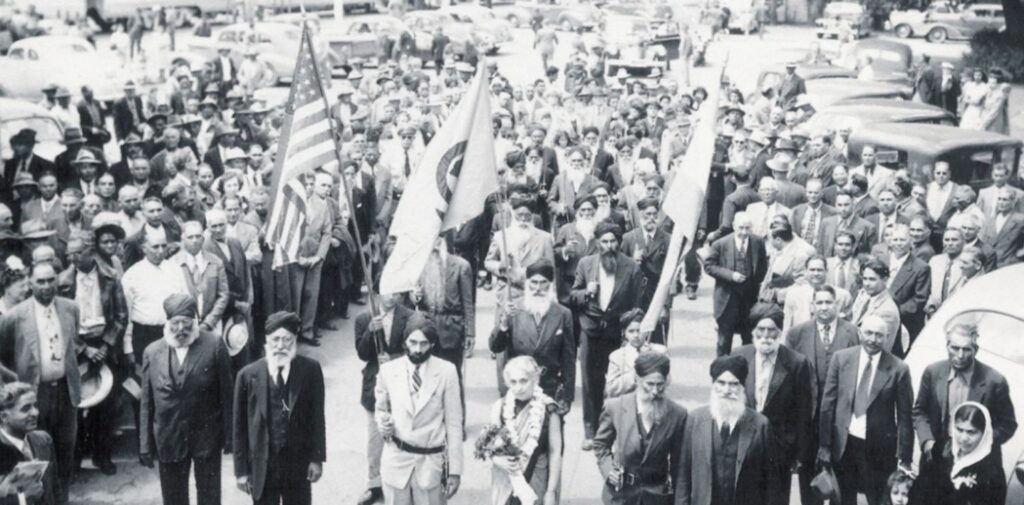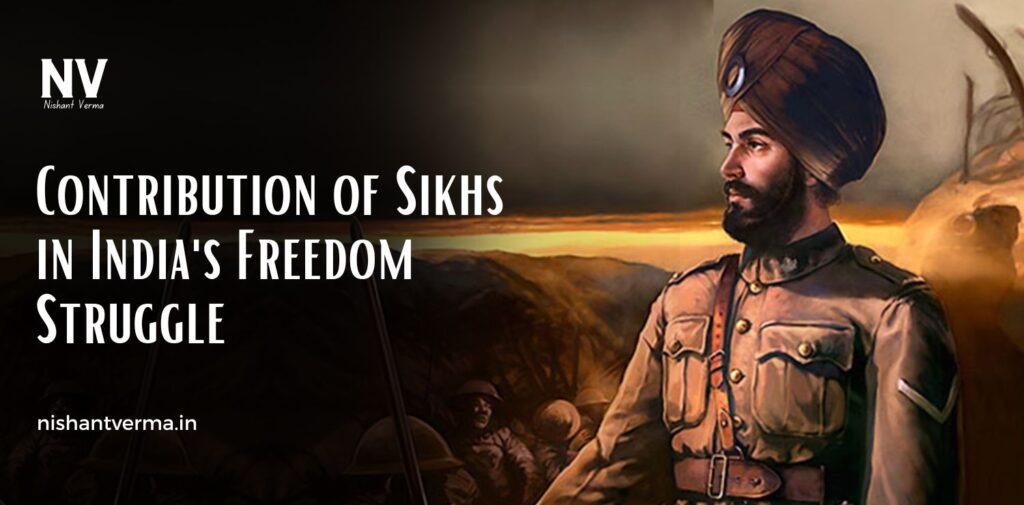The history of India’s fight for independence is rich and diverse, with contributions from people of all communities, regions, and backgrounds. Among the many groups that played a crucial role in the struggle against British colonial rule, the Sikhs stand out for their bravery, resilience, and selfless sacrifice. Their contribution to India’s freedom movement is a story of valor, patriotism, and unwavering commitment to justice. This article explores the significant Role & Contribution of Sikhs in India’s Freedom Struggle.
The Sikh Community’s Spirit of Resistance
The Sikh community, with its roots in the teachings of Guru Nanak and the subsequent Gurus, has always had a deep sense of equality, justice, and the defense of the oppressed. The Sikhs were never strangers to resistance, as their history is filled with struggles against tyranny and injustice. This spirit of resistance found a powerful expression during British rule, when Sikhs took active part in the fight for India’s freedom.
In the early days of British rule, Sikhs, who had been historically warriors under the Mughal Empire and later the Khalsa Army, brought their martial tradition and spirit to the forefront of India’s freedom struggle. Their contributions can be seen in various forms, including participation in armed uprisings, political movements, and social reforms.

The Sikh Role in the Revolt of 1857
One of the earliest and most significant contributions of Sikhs to India’s independence struggle came during the Revolt of 1857, also known as the First War of Indian Independence. Although the revolt was led by various Indian rulers and sepoys (Indian soldiers in the British army), Sikhs were among the most determined and committed participants.
Sikh soldiers played a pivotal role in the uprising, especially in regions like Delhi, Kanpur, and Lucknow. They fought alongside other rebel forces in their resistance to the British, and many Sikh leaders emerged as heroes during this time. For instance, leaders like Sardar Bada, Sardar Mangal Singh, and Sardar Kahan Singh were recognized for their bravery and leadership during the revolt.
While the Revolt of 1857 failed to overthrow the British, it was a turning point in India’s struggle for freedom. The participation of the Sikh community in the revolt helped ignite the fire of nationalism and resistance, which would burn brightly in the years to come.
Sikh Soldiers in the British Army
In the years after the Revolt of 1857, the British colonial rulers recognized the military prowess of the Sikhs and began to recruit them in large numbers into the British Indian Army. Sikhs became an integral part of the British Army, and their contributions in wars like World War I and World War II are well-documented.
However, during this period, many Sikhs began to feel increasingly disillusioned with the British. While the British had relied heavily on Sikh soldiers for their military campaigns, they did little to reward or uplift the Sikh community. This led to growing resentment toward British rule, especially among the younger generations of Sikhs.
By the early 20th century, the Sikh community had become more involved in political movements for Indian independence. The sense of injustice, coupled with the community’s long tradition of standing up for their rights, led many Sikhs to join the broader Indian nationalist movement.
Sikh Leaders in the Indian National Congress
The Indian National Congress (INC), the primary political organization leading the fight for independence, attracted the participation of many prominent Sikh leaders who played key roles in the movement.
1. Lala Lajpat Rai
One of the most famous Sikh leaders in the Indian freedom struggle was Lala Lajpat Rai. Known as ‘Punjab Kesari,’ Lajpat Rai was a prominent figure in the INC and a strong advocate for the rights of Indians under British rule. He was instrumental in organizing protests and campaigns against oppressive policies, including the Simon Commission.
In 1928, Lajpat Rai led a protest in Lahore against the Simon Commission, which was set up by the British without any Indian representation. During the protest, he was severely beaten by the police, which led to his death a few days later. His sacrifice became a symbol of the courage and determination of the Sikh community and India’s struggle for independence.
2. Sardar Kitchlew and Sardar Patel
Sardar Kitchlew, a prominent Sikh leader from Punjab, was an important figure in the freedom struggle. He played a significant role in organizing protests against British policies, particularly the Rowlatt Act of 1919, which allowed the British to arrest and detain Indians without trial. Sardar Kitchlew was arrested along with Dr. Saifuddin Kitchlew, and their imprisonment led to widespread protests in Punjab and across India.
Sardar Vallabhbhai Patel, though not a Sikh, worked closely with Sikh leaders during the freedom struggle. He was instrumental in uniting diverse communities under the banner of the Indian National Congress and played a key role in organizing nonviolent protests and civil disobedience.

The Role of Sikhs in the Ghadar Movement
The Ghadar Movement of 1913, which was an armed struggle aimed at overthrowing British rule, was another significant chapter in the Sikh contribution to India’s freedom struggle. The movement was initiated by Sikh immigrants, particularly those in the United States and Canada, who were deeply inspired by the nationalist sentiments emerging in India.
The Ghadar Party, founded by Lala Hardayal and other Sikh revolutionaries, aimed to inspire Indian soldiers and workers abroad to rise against British rule. The movement gained momentum in the early 20th century and became a symbol of resistance for Sikhs, particularly in the United States, where the movement’s influence was widespread.
The Ghadar movement was not limited to just a political struggle; it also promoted the idea of unity between Hindus, Sikhs, and Muslims. The Sikhs who joined the movement were prepared to give their lives for the cause of India’s independence. Although the movement was eventually suppressed by the British, it played a crucial role in sowing the seeds of rebellion and radical nationalism.
The Khilafat Movement and Sikh Participation
In the 1920s, India saw the rise of the Khilafat Movement, a pan-Islamic campaign that sought to protect the Ottoman Caliphate after World War I. While this movement was primarily led by Muslim leaders like Maulana Abul Kalam Azad and Shaukat Ali, Sikhs played an important role in supporting it.
Sikh leaders recognized the importance of religious unity and joined hands with Muslim leaders in their demand for the protection of the Caliphate. This solidarity between Hindus, Muslims, and Sikhs helped strengthen the anti-British sentiment across the country, showing that religious differences were secondary to the shared goal of independence.
The Role of Sikhs in the Indian Army During World War II
During World War II, the British again turned to the Indian soldiers, including many Sikhs, to fight in the war. Many Sikhs, however, began to see the war as an opportunity to challenge British rule. While some fought under British command, others saw the war as a chance to rise against colonial oppression.
The contribution of Sikhs in World War II is notable for their sacrifice and courage, but it also deepened the frustration and discontent among them. The British failed to offer any meaningful political concessions after the war, which led to a growing demand for full independence.

The Final Struggle and the Sikh Contribution to Partition
By the 1940s, the demand for independence had gained widespread support, with leaders like Mahatma Gandhi, Jawaharlal Nehru, and Subhas Chandra Bose leading the charge. Sikhs, too, continued to participate in major movements like the Quit India Movement (1942), which called for an immediate end to British rule.
However, the partition of India in 1947, which resulted in the creation of Pakistan, marked a tragic chapter for Sikhs. Many Sikhs were displaced during the partition, and the violence and bloodshed that accompanied it left deep scars. Despite the turmoil, Sikhs remained committed to the ideals of the Indian freedom struggle, and their role in securing independence remained a proud and integral part of India’s history.
Conclusion: Contribution of Sikhs
The contribution of Sikhs to India’s freedom struggle is vast and varied, spanning from the Revolt of 1857 to the final moments of independence in 1947. Sikhs played a significant role in shaping the course of the independence movement, both through armed resistance and political activism. Their bravery, sacrifice, and unwavering commitment to justice have left an indelible mark on the history of India’s fight for freedom.
Whether through participation in key political movements, the Ghadar struggle, or the battles fought in World War I and World War II, the Sikh community’s contribution was critical in bringing about India’s independence. Their role in the fight for freedom continues to inspire generations and stands as a testament to their courage and patriotism.




